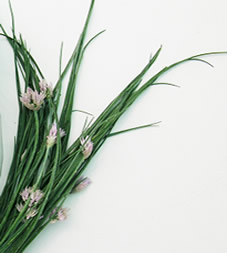Chives
Dill
Absinthe
Basil
Borage
Calamint
Capers
Chervil
Coriander
Tarragon
Chives
Wild fennel
Lavender
Lovage
Lippia Citriodora
Marjoram
Lemon balm
Mint
Myrtle
Oregano
Chilli pepper
Salad burnet
Parsley
Rosemary
Garden rocket
Rue
Sage
Celery
Thyme
Valerian
HISTORICAL HINTS: known since ancient times, chives is mentioned in different recipes by Apicius while, in the Middle Age it was cultivated for culinary use. Celts believed it to be magical and used it to eliminate evil eye or any bad spell. The word “allium” comes from Celtic language and mean “warm, burning”. Beside its aromatic use, since 3000 B.C, chives was also used as an antidote for snake bites and as antihaemorragic. Its name comes from the Greek “schoenos” (cane) and “prason” (leek).
THE PLANT - Chives (Alium Schoenoprasum L.) is a perennial herbaceous plant belonging to the Liliaceae family originally from northern Europe, Asia and northern America (Canada), and it grows in temperate-cold, cold areas. It is very common in kitchen gardens and it is very resistant to parasites attacks; chives is a perfumed leaved aromatic plant reminding onion taste and it has a grey-brownish oval bulb and hollow cylindrical 40 cm long stemmed leaves which have a bright green colour; pink-purplish flowers, are gathered in spherical inflorescences and surrounded by a membrane which falls with blooming.
CULTIVATION AND HARVESTING - Chives grows on moist lawns from 600 to 2500 m and in Italy it is cultivated in the mainland up to Tuscany region. Chives can be harvested at any time because its long and thin leaves grow again after every cut. Stalk must be cut at the base, leaving some centimetres for re-growing and are excellent if used fresh.
CONSUMPTION –
When you buy chives it must have a bright colour, flashy, erected and tonic leaves with a strong aroma.
PRESERVATION - Chives is generally harvested and used fresh but it can also be stored for about 3-4 days in the vegetable compartment of the fridge, or after slicing it up, chives can be put in hermetically closed plastic bags and frozen or in hermetic glass pots. Even if it can be found on the market, dry chives is not recommended.
PROPERTIES - Chives contains vitamin C, phosphorus and oligoelements.
It has different properties: depurative, digestive, diuretic, it also an excellent antiseptic, helps to heal wounds, expectorant, laxative, cardio tonic and stimulating. In ancient times it was used to stimulate appetite.
CULINARY USE –
Chives is used for a lot of dishes; certainly in all those recipes requiring onion: the result will be more delicate. Also its flowers, which have the same delicate onion-like taste, are edible and are used to decorate salads and other dishes.
Generally it is used to prepare sauces, eggs, omelettes, crepes, salty pies, soft cheeses, soups, gravies, aromatized butter, salads, sour cream on jacket potatoes, fish and meat courses.
Thanks to the flexibility of its stems it is also used for decorative purposes, for example to tie small crepe bundles or bunches of boiled asparagus.























